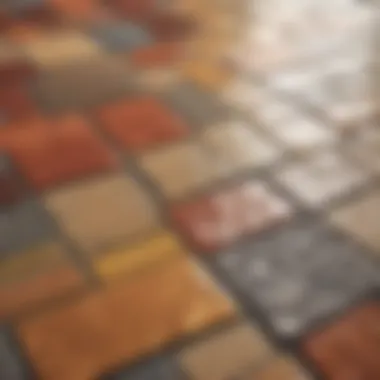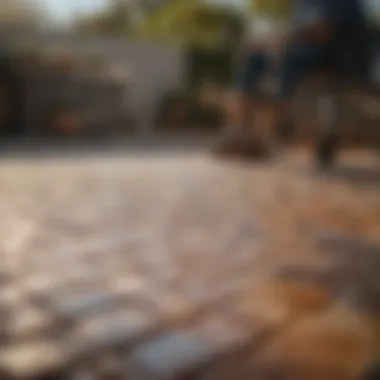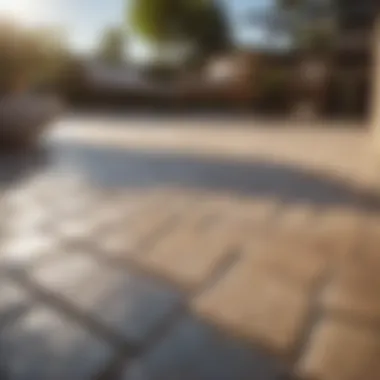Materials:
- Paver sealer
- Paint roller
- Paint tray
- Paintbrush
- Pressure washer
- Concrete cleaner
- Scrub brush
- Water hose
- Bucket
- Protective gear (gloves, goggles, mask)
- Stir stick
DIY Steps:
-
Prepare the Pavers: Clean the pavers thoroughly using a pressure washer, concrete cleaner, scrub brush, and water. Allow them to dry completely.
-
Mix the Sealer: Stir the paver sealer thoroughly to ensure uniform consistency.
-
Apply the Sealer: Pour the sealer into a paint tray, use a paint roller to apply an even coat on the pavers. Use a paintbrush for edges and corners.
-
Second Coat (if needed): Apply a second coat after the first one dries according to the sealer instructions.
-
Final Touches: Allow the sealer to dry completely before walking on the pavers.
Technical Aspects:
- Timing: Choose a dry day with temperatures between 50-80°F for optimal drying conditions.
- Tools: Utilize a pressure washer, paint roller, paint tray, paintbrush, etc., for a smooth application.
- Key Techniques: Ensure even application of sealer, work in sections to avoid overlaps.
DIY Project Process:


-
Start with Clean Pavers: Ensure the pavers are free from debris and stains for the sealer to adhere properly.
-
Even Application: Apply the sealer evenly in a controlled manner to avoid drips or puddles.
-
Dry Time: Allow adequate drying time between coats as per the sealer instructions.
-
Troubleshooting Tips: If the sealer puddles or bubbles, use a paint roller to spread it evenly. Avoid applying too thick a coat.
This detailed guide equips you with the precise steps, materials, and techniques needed to coat your patio pavers effectively, enhancing their appearance and longevity for your outdoor enjoyment.
Introduction


Imagine stepping out into your backyard oasis, where beautifully coated patio pavers greet your every step, enhancing both the aesthetics and longevity of your outdoor space. This ultimate guide to coating patio pavers is your go-to resource for transforming your outdoor haven into a stunning retreat. From the initial preparation phase to the meticulous application process and essential maintenance tips, this guide covers every aspect of achieving remarkable results.
Importance of Coating Patio Pavers
Ensuring the durability and longevity of your patio pavers is crucial in preserving the beauty and functionality of your outdoor living area. By applying a quality coating, you not only enhance the visual appeal of your space but also provide essential protection against wear and tear, weather elements, and daily usage. A properly coated patio not only looks inviting but also stands the test of time, reducing maintenance efforts and costs in the long run.
Benefits of Coating Patio Pavers
Coating your patio pavers offers a plethora of benefits that go beyond just enhancing their appearance. From offering exceptional protection against stains, mold, and UV rays to improving the overall durability and lifespan of your pavers, the benefits are truly multifaceted. Additionally, a well-coated patio is easier to clean and maintain, ensuring that your outdoor space remains pristine with minimal effort. Moreover, the aesthetic enhancement provided by coatings can instantly elevate the look of your patio, creating a welcoming and stylish outdoor environment for you and your guests to enjoy.
Preparation Phase


The Preparation Phase is a critical stage in the process of coating patio pavers as it sets the foundation for a successful application. Proper preparation ensures that the surface is clean, smooth, and ready to receive the coating, promoting adhesion and longevity. This preliminary step plays a vital role in the overall outcome of the project, impacting the durability and aesthetics of the coated patio pavers.
Taking the time to engage in thorough preparation allows for the removal of dirt, grime, and any existing coatings, creating a pristine canvas for the new coating to adhere to effectively. By prioritizing the Preparation Phase, homeowners can ensure that their patio pavers are adequately prepped to withstand various environmental stressors and foot traffic, prolonging the lifespan of the coating and the overall visual appeal of the outdoor space.
To achieve optimal results during the Preparation Phase, it is essential to consider factors such as the type of coating being applied, the current condition of the patio pavers, and any specific requirements outlined by the coating manufacturer. By meticulously preparing the surface, homeowners can maximize the benefits of the coating, including improved resistance to stains, water damage, and UV exposure.
Cleaning the Patio Pavers
Sweeping and Clearing Debris
Sweeping and clearing debris are fundamental tasks within the Cleaning phase of coating patio pavers. This process involves removing loose dirt, leaves, twigs, and other debris that may have accumulated on the surface of the pavers. Not only does this enhance the aesthetic appeal of the patio area, but it also prevents debris from interfering with the coating application.
One key characteristic of sweeping and clearing debris is its simplicity yet effectiveness in preparing the surface for coating. By eliminating debris, homeowners can achieve a smooth and clean base, ensuring that the coating adheres uniformly and degrading substances do not undermine its performance. This method is a popular choice for its accessibility and immediate impact on the overall look of the patio.
While sweeping and clearing debris are cost-effective and time-efficient, it is important to note that this method may not address deeply embedded stains or stubborn contaminants. Homeowners should assess the extent of debris accumulation and consider complementary cleaning techniques for a comprehensive surface preparation process.
Pressure Washing
Pressure washing is a powerful cleaning method that utilizes pressurized water to remove tough stains, dirt, and grime from the surface of patio pavers. This technique contributes significantly to the overall cleanliness and readiness of the pavers for coating, achieving a level of deep cleaning that standard sweeping may not accomplish.
The key characteristic of pressure washing lies in its high-pressure stream, which penetrates porous surfaces and dislodges stubborn particles, revealing a fresh surface underneath. This thorough cleaning approach ensures that the coating binds securely to the pavers, minimizing the risk of adhesion issues and maintaining the longevity of the protective layer.
One unique feature of pressure washing is its versatility in handling various types of contaminants, including mold, mildew, and algae, which can compromise the integrity of the coating if left untreated. However, caution must be exercised with pressure washing to prevent damage to the pavers' surface, especially in delicate or aging materials.
Repairing Damaged Pavers
Replacing Cracked Pavers
Replacing cracked pavers is a crucial aspect of the Repairing phase, addressing structural issues and ensuring the stability of the patio surface. This method involves removing damaged pavers and replacing them with new ones to maintain the uniformity and strength of the pavement.
The key characteristic of replacing cracked pavers is its ability to resolve localized damage effectively, preventing further deterioration and safeguarding the integrity of the entire patio area. By utilizing this repair approach, homeowners can rectify visibly compromised sections, enhancing the durability and aesthetics of the outdoor space.
One unique feature of replacing cracked pavers is its potential to transform the look of the patio, allowing for customizations in color, shape, and texture. While this method offers a long-lasting solution to structural issues, homeowners should ensure that the replacement pavers match the existing ones to create a seamless appearance.
Filling in Gaps
Filling in gaps between patio pavers is a task that addresses both aesthetic concerns and structural integrity. This process involves applying a filler material to spaces where pavers have shifted, creating a unified surface that reduces tripping hazards and enhances the visual cohesiveness of the pavement.
The key characteristic of filling in gaps is its ability to stabilize the pavers and prevent weeds from growing between the joints, minimizing maintenance efforts and preserving the seamless look of the patio. This technique is a popular choice for restoring the uniformity of the surface and revitalizing the overall appeal of the outdoor space.
One advantage of filling in gaps is the customizable nature of the filler material, allowing homeowners to select options that blend harmoniously with the existing pavers and complement the overall design scheme. While filling in gaps improves the functionality and appearance of the patio, regular inspection and maintenance are recommended to address shifting pavers and maintain structural integrity over time.
Choosing the Right Coating
Choosing the right coating for your patio pavers is a critical step in the enhancement process. The coating acts as a protective barrier, ensuring that your pavers withstand the elements and daily wear and tear while also adding aesthetic appeal. This section delves into the different types of coatings available and the key factors to consider when making this important decision. It is essential to select a coating that aligns with your specific needs and complements the overall look of your outdoor space.
Types of Coatings
Acrylic Sealers
Acrylic sealers are a popular choice for coating patio pavers due to their durability and versatility. These sealers form a protective layer on the surface of the pavers, enhancing their resistance to stains, UV rays, and water damage. One key characteristic of acrylic sealers is their ability to provide a glossy or matte finish, allowing you to achieve your desired look. While acrylic sealers offer excellent protection, they may require more frequent reapplication compared to other coatings.
Epoxy Coatings
Epoxy coatings are known for their exceptionally strong bond with pavers, creating a resilient surface that can withstand heavy foot traffic and harsh weather conditions. One of the key advantages of epoxy coatings is their seamless finish, which offers a smooth and uniform appearance. While epoxy coatings provide outstanding durability, they can be more challenging to apply and may require professional assistance for optimal results.
Urethane Coatings
Urethane coatings are valued for their exceptional resistance to abrasions, chemicals, and UV exposure, making them a suitable choice for high-traffic areas. These coatings offer a durable protective layer that enhances the lifespan of patio pavers. A key characteristic of urethane coatings is their flexibility, allowing them to expand and contract with the pavers during temperature variations. While urethane coatings excel in durability, they may require specialized application techniques for proper adhesion.
Factors to Consider
Durability
Durability is a crucial consideration when choosing a coating for patio pavers. A durable coating ensures that your pavers maintain their integrity and appearance over time, even in harsh environmental conditions. By selecting a coating known for its longevity and resistance to wear, you can enjoy your beautifully coated pavers for years to come.
Aesthetics
Aesthetics play a significant role in enhancing the visual appeal of your outdoor space. Consider a coating that not only protects your pavers but also adds to the overall charm of your patio or garden. Whether you prefer a glossy, wet look or a natural matte finish, the coating you choose should complement the existing design elements and architecture of your outdoor area.
Maintenance
Maintenance requirements are essential to factor in when selecting a coating for patio pavers. Some coatings may necessitate periodic reapplication or special cleaning processes to preserve their protective properties. Understanding the maintenance needs of each type of coating can help you prepare for ongoing care and ensure the longevity of your coated pavers.
Application Process
Surface Preparation
Ensuring Dryness
Ensuring Dryness plays a pivotal role in the overall success of the coating application process. By meticulously ensuring that the pavers are completely dry before applying the coating, homeowners can prevent moisture-related issues and achieve a long-lasting finish. The key characteristic of Ensuring Dryness lies in its ability to create a clean and stable surface for the coating to adhere to, eliminating the risk of peeling or bubbling. This best practice is a popular choice for this article because it significantly contributes to the longevity and effectiveness of the coating, ensuring that the final result meets high standards of quality. The unique feature of Ensuring Dryness lies in its ability to optimize the adhesion of the coating, providing a strong bond that enhances durability while mitigating the risk of potential damage from moisture infiltration.
Applying Primer
The process of Applying Primer is essential for preparing the surface of patio pavers before the coating application. This step helps to create a smooth and uniform surface, facilitating better adhesion and ensuring a consistent finish. The key characteristic of Applying Primer lies in its ability to enhance the bonding strength between the pavers and the coating, promoting greater longevity and durability. This step is a beneficial choice for this article as it enhances the overall effectiveness of the coating, ensuring that it adheres securely to the surface for long-lasting results. The unique feature of Applying Primer is its ability to provide a protective barrier that shields the pavers from environmental factors, thereby increasing their resilience and maintaining their aesthetic appeal over time.
Coating Application
Roller Application
When it comes to Coating Application, the Roller Application method stands out for its efficiency and ease of use. This technique involves using a roller to apply the coating evenly across the surface of the pavers, ensuring a seamless finish. The key characteristic of Roller Application is its ability to cover large areas quickly and uniformly, saving time and effort during the application process. This method is a popular choice for this article due to its simplicity and effectiveness in achieving a professional-looking result. The unique feature of Roller Application lies in its versatility, allowing homeowners to apply the coating smoothly and consistently, resulting in a visually appealing finish that enhances the overall appearance of the patio pavers.
Spray Application
In the realm of Coating Application, the Spray Application method offers a convenient and efficient way to coat patio pavers. This technique involves using a sprayer to evenly distribute the coating across the pavers, ensuring a uniform coverage. The key characteristic of Spray Application is its ability to reach intricate corners and crevices with ease, ensuring thorough application and a seamless finish. This method is a beneficial choice for this article as it provides a time-saving solution for coating larger surface areas quickly and efficiently. The unique feature of Spray Application lies in its ability to create a smooth and professional finish, enhancing the aesthetics and longevity of the patio pavers while minimizing wastage and ensuring an even coating application.
Maintenance Tips
In the realm of enhancing and maintaining your patio pavers, the maintenance tips section of this in-depth guide plays a pivotal role in preserving the beauty and longevity of your outdoor space. Maintenance serves as the backbone of sustaining the appeal and functionality of coated pavers, ensuring they withstand the test of time and environmental elements. By adhering to a proper maintenance routine, you not only uphold the visual charm of your patio but also safeguard your investment in enhancing your outdoor living area. Delving into the maintenance aspect is crucial to comprehensively understanding the upkeep required for coated patio pavers.
Regular Cleaning
Regular cleaning stands as a fundamental aspect of preserving the allure and structural integrity of your patio pavers post-coating. This step involves routine removal of dust, dirt, and other debris that may accumulate on the surface over time, detracting from the aesthetic appeal of your outdoor space. By incorporating a scheduled cleaning regimen, you prevent the build-up of grime and stains, maintaining the pristine look of your coated pavers. Utilizing appropriate cleaning agents and tools tailored to the specific coating material is essential to ensure effective removal of contaminants without compromising the coating's integrity.
Reapplication Schedule
Equally important as regular cleaning is establishing a well-defined reapplication schedule for maintaining the protective coating on your patio pavers. Over time, environmental factors, foot traffic, and exposure to sunlight can gradually wear down the coating, diminishing its effectiveness in safeguarding the pavers. By outlining a reapplication schedule based on the type of coating used and the level of outdoor foot traffic, you can proactively extend the lifespan of the coating and ensure continuous protection for your patio pavers. This proactive approach to reapplication enables you to address any signs of wear and tear promptly, preventing potential damage to the pavers and preserving the overall visual appeal of your outdoor space.





